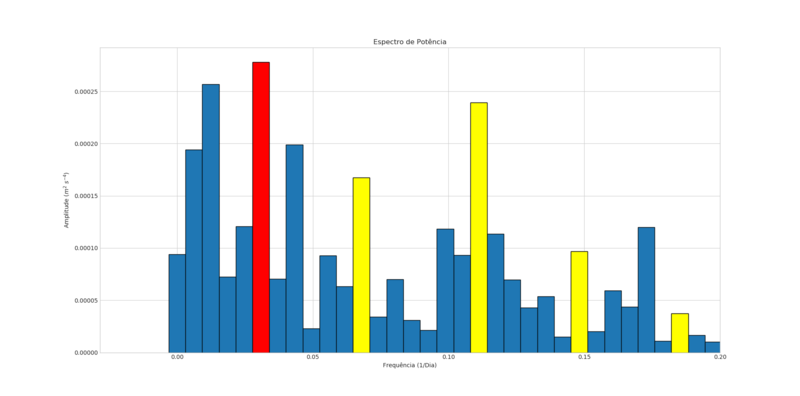Difference between revisions of "Tidal study"
(Created page with "The gravitational effects of the Moon on the Earth can be verified on a wide raging spectrum of natural systems. Some have pronounced effects, such as sea tides, but other hav...") |
|||
| Line 10: | Line 10: | ||
[[File:Dft man.png||thumb|Figura 1 - Power spectrum obtained with data collected from the 12th March 2018 to the 14th of May of 2018. In red is the spectral component corresponding to the lunar period, of 29 days, and in yellow its subharmonic components.|center|border|800px]] | [[File:Dft man.png||thumb|Figura 1 - Power spectrum obtained with data collected from the 12th March 2018 to the 14th of May of 2018. In red is the spectral component corresponding to the lunar period, of 29 days, and in yellow its subharmonic components.|center|border|800px]] | ||
| − | This concept was exposed in a [[:file:Poster.pdf|poster (in portuguese)]] titled "Variação da gravidade local em função do período sinódico da Lua" (Changes in local gravity as a function of the synodic period of the Moon). This poster was presented at FÍSICA2018 – 21ª Conferência Nacional de Física e 28º Encontro Ibérico para o Ensino da Física (21st National Physics Conference and Iberian Encounter for the Teaching of Physics) and was awarded the prize for best poster by the education division. | + | This concept was exposed in a [[:file:Poster.pdf|poster (in portuguese)]] titled "Variação da gravidade local em função do período sinódico da Lua" (Changes in local gravity as a function of the synodic period of the Moon). This poster was presented at FÍSICA2018 – 21ª Conferência Nacional de Física e 28º Encontro Ibérico para o Ensino da Física (21st National Physics Conference and 28th Iberian Encounter for the Teaching of Physics) and was awarded the prize for best poster by the education division. |
Revision as of 02:39, 16 November 2018
The gravitational effects of the Moon on the Earth can be verified on a wide raging spectrum of natural systems. Some have pronounced effects, such as sea tides, but other have a more subtle nature, such as atmospheric tides or earth tides. Using a pendulum it's possible to determine the orbital period of the Moon through the study of one of the more subtle effect of the Earth-Moon gravitational interaction, changes of local gravity at the surface of the Earth in function of the position of the Moon in its orbit. This was accomplished by using the remote pendulum of São Tomé e Príncipe, with daily experimental runs at local solar midnight (23h32 local time).
Although the precision of the experimental apparatus is lower than the effect being observed (noise > measurement), it's possible, through oversampling of data from various Moon orbits, to overcome this limitation and determine the orbital period of the Moon (signal).
Using data collected from 12/03/2018 to 14/05/2018, with one experimental run per day, and calculating the power spectrum through a Discrete Fourier Transform of size 64, figure 1 was obtained. In it are pictured the different spectral components of the signal. In red is the main component with period 29 days, the one corresponding to the synodic period of the Moon, and in yellow are the subharmonics of this main component. Therefore, it's possible to verify that the local gravity changes in such a way that some of its spectral components have the same period of the lunar orbit, as expected. It's also possible to see that a lower frequency component is present (bars to the left of the red bar) and this component has a significant contribution to the signal. It is possible that this contribution is caused by the change of average distante from Moon to the Earth, which is not constant in time, although no further efforts to confirm this hypotheses were done.
The original data collected during the experiment will be made available here as soon as possible.
This concept was exposed in a poster (in portuguese) titled "Variação da gravidade local em função do período sinódico da Lua" (Changes in local gravity as a function of the synodic period of the Moon). This poster was presented at FÍSICA2018 – 21ª Conferência Nacional de Física e 28º Encontro Ibérico para o Ensino da Física (21st National Physics Conference and 28th Iberian Encounter for the Teaching of Physics) and was awarded the prize for best poster by the education division.
